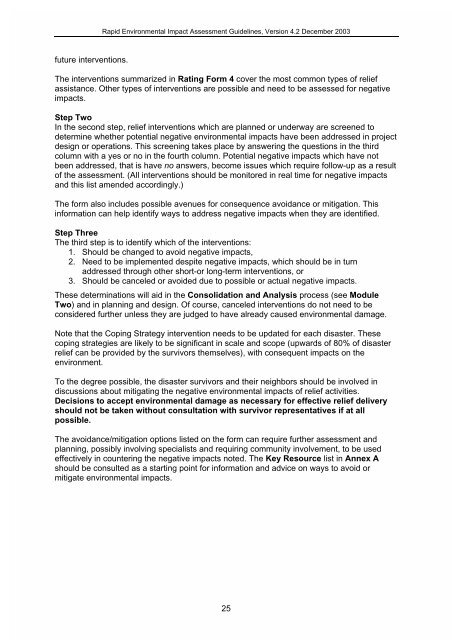Guidelines for Rapid Environmental Impact Assessment in Disasters
Guidelines for Rapid Environmental Impact Assessment in Disasters
Guidelines for Rapid Environmental Impact Assessment in Disasters
Create successful ePaper yourself
Turn your PDF publications into a flip-book with our unique Google optimized e-Paper software.
future <strong>in</strong>terventions.<br />
<strong>Rapid</strong> <strong>Environmental</strong> <strong>Impact</strong> <strong>Assessment</strong> <strong>Guidel<strong>in</strong>es</strong>, Version 4.2 December 2003<br />
The <strong>in</strong>terventions summarized <strong>in</strong> Rat<strong>in</strong>g Form 4 cover the most common types of relief<br />
assistance. Other types of <strong>in</strong>terventions are possible and need to be assessed <strong>for</strong> negative<br />
impacts.<br />
Step Two<br />
In the second step, relief <strong>in</strong>terventions which are planned or underway are screened to<br />
determ<strong>in</strong>e whether potential negative environmental impacts have been addressed <strong>in</strong> project<br />
design or operations. This screen<strong>in</strong>g takes place by answer<strong>in</strong>g the questions <strong>in</strong> the third<br />
column with a yes or no <strong>in</strong> the fourth column. Potential negative impacts which have not<br />
been addressed, that is have no answers, become issues which require follow-up as a result<br />
of the assessment. (All <strong>in</strong>terventions should be monitored <strong>in</strong> real time <strong>for</strong> negative impacts<br />
and this list amended accord<strong>in</strong>gly.)<br />
The <strong>for</strong>m also <strong>in</strong>cludes possible avenues <strong>for</strong> consequence avoidance or mitigation. This<br />
<strong>in</strong><strong>for</strong>mation can help identify ways to address negative impacts when they are identified.<br />
Step Three<br />
The third step is to identify which of the <strong>in</strong>terventions:<br />
1. Should be changed to avoid negative impacts,<br />
2. Need to be implemented despite negative impacts, which should be <strong>in</strong> turn<br />
addressed through other short-or long-term <strong>in</strong>terventions, or<br />
3. Should be canceled or avoided due to possible or actual negative impacts.<br />
These determ<strong>in</strong>ations will aid <strong>in</strong> the Consolidation and Analysis process (see Module<br />
Two) and <strong>in</strong> plann<strong>in</strong>g and design. Of course, canceled <strong>in</strong>terventions do not need to be<br />
considered further unless they are judged to have already caused environmental damage.<br />
Note that the Cop<strong>in</strong>g Strategy <strong>in</strong>tervention needs to be updated <strong>for</strong> each disaster. These<br />
cop<strong>in</strong>g strategies are likely to be significant <strong>in</strong> scale and scope (upwards of 80% of disaster<br />
relief can be provided by the survivors themselves), with consequent impacts on the<br />
environment.<br />
To the degree possible, the disaster survivors and their neighbors should be <strong>in</strong>volved <strong>in</strong><br />
discussions about mitigat<strong>in</strong>g the negative environmental impacts of relief activities.<br />
Decisions to accept environmental damage as necessary <strong>for</strong> effective relief delivery<br />
should not be taken without consultation with survivor representatives if at all<br />
possible.<br />
The avoidance/mitigation options listed on the <strong>for</strong>m can require further assessment and<br />
plann<strong>in</strong>g, possibly <strong>in</strong>volv<strong>in</strong>g specialists and requir<strong>in</strong>g community <strong>in</strong>volvement, to be used<br />
effectively <strong>in</strong> counter<strong>in</strong>g the negative impacts noted. The Key Resource list <strong>in</strong> Annex A<br />
should be consulted as a start<strong>in</strong>g po<strong>in</strong>t <strong>for</strong> <strong>in</strong><strong>for</strong>mation and advice on ways to avoid or<br />
mitigate environmental impacts.<br />
25
















